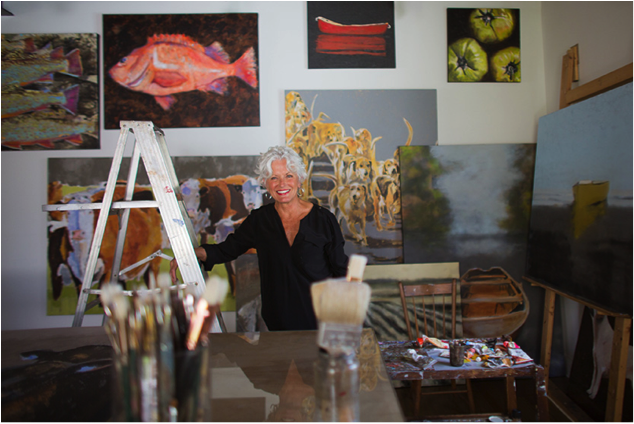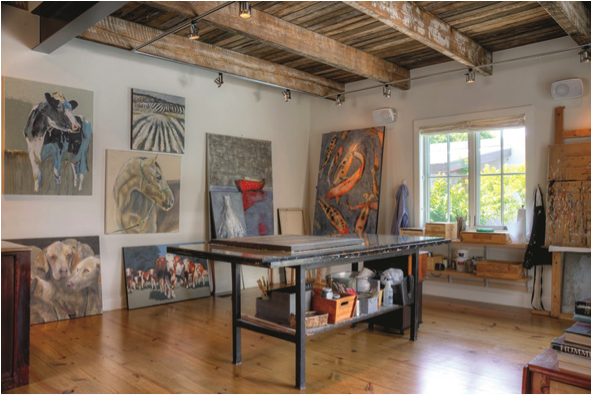Ballard Designs Interview

I wanted to share a wonderful interview from Ballard Designs. Hopefully it will give you more information regarding my art as well as give glory to God, who makes all things (even my art) possible!
…

Ballard Designs: Tell us a little about yourself and your path to becoming an artist.
Carylon Killebrew: In the fourth grade my teacher told me I was going to be an artist, and I just took her word for it. That’s why I went to college to study art. My focus was in Italian printmaking, and I continued that after college until a gallery owner in Atlanta told me she loved my work but that her clients wanted larger pieces. The press bed will only accommodate certain sizes, so she suggested I start painting large pieces on canvas. It turned out I loved painting large-scale. That was at least 20 years ago.
BD: And the rest is history?
CK: Not exactly! I took a 20-year sabbatical to raise a family. We had four children — and now I have 11 grandchildren — and I didn’t try to do art during that time. I just kind of put it on the shelf. I got into the fitness industry and developed a fitness center here in Chattanooga, because that was something I could do with the kids. Once the kids were settled, I got back into art. (Editor’s note: Carylon received the Governor’s award for physical fitness for raising awareness of the need for fitness programs in Chattanooga.)
BD: How would you describe your art?
CK: Minimalist. I keep it in the back of mind always to identify the essential and eliminate everything else. Typically, I start with a particular form, which I refer to as an icon. I use icons in my work, and it’s actually how my art is divided on my website: Figurative, Boats and Water, Still Life, Cows, and Hounds and Horses.
BD: Boats is one of your popular series. Can you explain the significance of this icon?
CK: The boat is an icon for surrender, peace, stillness and rest. You have to get into that boat, but once you’ve entered it, everything you need for a moment in time is inside that boat. The headmaster of the Baylor School here in Chattanooga wrote a book and he used to say, “I love a boat. A boat is small enough to create an order, one that is complete and satisfying even though the rest of your life is in chaos.” I really identify with that.
BD: So starting from an icon that is representative of an idea is what inspires your work?
CK: Absolutely. Each one of these icons is about getting down to the essence of an emotion, a memory or a thing. Trying desperately to put a thought with an image in the most simplified, honest way that I can. I totally appreciate people who give lots and lots of detail to their work, but that’s not who I am. I paint with big brushes and I paint really quickly. My husband says I paint like the studio is burning down. I have more energy than I know what do with. And I think sometimes that comes across on the canvas, but hopefully it comes across in an uncluttered, simple way.
BD: As you said, your boat scenes exude a certain quietude, not unlike your cows. So…why cows?
CK: While we raised our children we lived on a city farm that’s actually just two miles from downtown Chattanooga where we had cows, horses and chickens on 20 acres. We lived there for 30 years. I’ve always loved cows. It’s their strength and their calmness. They’re also gentle, quiet and humble. I also love to paint horses, but they are intimidating. Horses know more than I do. Cows do not!
BD: One of our favorites is Mango the Cow. You actually have the original on your wall at home.
CK: I do! It’s hanging in my kitchen. That is not based on a cow we owned. We have a place in North Carolina, and when we’re driving along, my husband will pull the car over if he sees a cow he thinks I might want to take shots of. I gather photographs from all these cows and use them for inspiration. When I do these series, I get stuck on, say, cows for a while and I think, “I’ll never paint another cow!” And three months later I’m painting another cow. It always makes me think of Georgia O’Keefe, who, of course, painted the same thing over and over. She said, “It belongs to me. God told me if I painted it enough, I could have it.” I love that!
BD: Can you describe your creative process? What does an average day look like for you?
CK: I’m a Christian and all my work is faith-based. My typical day begins at 4 a.m. — I told you I had way too much energy! I’m in my bed at 3:30 waiting for it to be 4. I just cannot wait to get out of bed. By that time, I already know what it is that I want to do, and I come down and turn on music. I have a very eclectic play list, but in the morning, I listen to Christian instrumental for the first two hours of my day. I pray that God will honor the work of my hands, and for those two hours I paint in the darkness of the morning. Then my husband gets up, and we sit and have a devotional before he goes to work and I go back to the studio. Our home is a landing pad for my family and grandkids, so they come and go during the day. I might have to pick up someone and take them to climbing or tutoring or what have you. I’ll have windows of opportunity all day long to go back into the studio, but the thought process and the foundation is done in the wee hours of the morning.

Carylon’s studio; Photo: Huff Harrington
BD: Do you start one piece and work on that one piece until it’s finished?
CK: No, I’m too ADD for that! I’ll start one piece in the early morning, but I probably have about four things going in the studio at one time. Sometimes I’ll prop things up throughout the house just to be able to walk by and catch it in my peripheral vision and think about what’s working or not and see if something pops out at me. It’s a really good thing to live with that piece and make changes along the way like that.
BD: Would you say your style has evolved over the years?
CK: You know I was hoping it would! But sometimes when I look back at some of my older work, I think, “Oh, you’re still doing that” or “You’re still applying it like this.” I think there’s a part of me that will always apply paint to the canvas in the only way I know how to, but I’m constantly learning and watching and taking in other work. I’m totally inspired by other people’s art and what they’re doing, so hopefully those influences are being compressed down into my work. But I basically do the same work. It doesn’t really matter if it’s a figurative piece or a boat or a cow. What I’m looking at is value — light and dark. I look at the planes of the face, or the planes on a cow or the planes where the light hits the boat. All of that is the same — it doesn’t matter what the imagery is.
BD: We’re so excited to have you as an exclusive artist and to have pieces of your work that our customers won’t find anywhere else. Why did you decide to work with Ballard?
CK: We love Provence and Italy, and we love to travel and take tons of photos. Our home is a reflection of that aesthetic, and we see that same aesthetic in Ballard Designs. It is a European-influenced catalog. It looked like a good fit to me. I hope I’ll be worthy!
BD: How do you envision people enjoying your art in their homes?
CK: My daughters have come with me to a few outdoor exhibits I’ve had, and they always say, “Mom, when people walk by your booth, they all smile.” There’s enough hard stuff in life. I want people to enjoy my work and smile when they see it. When you choose something for your home, I hope it would be something that makes you smile and brings you enjoyment.
BD: What brings you enjoyment or inspiration these days?
CK: I illustrated a children’s book about a true story of a rescue dog not too long ago, and I would like to once again incorporate writing and visuals together. If I were to do another residency in training for a month away from home, I would focus on another illustrated book.
Whatever you do, just keep making us smile! Thanks, Carylon.